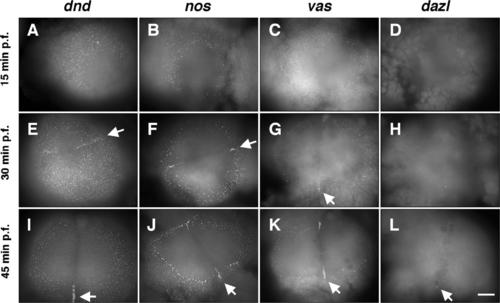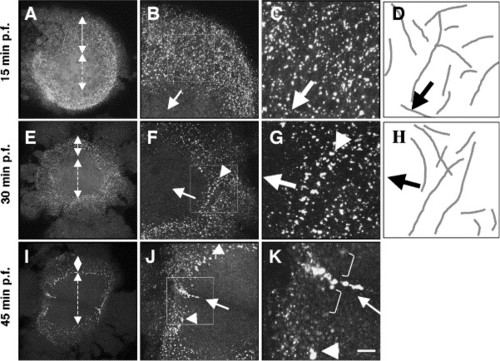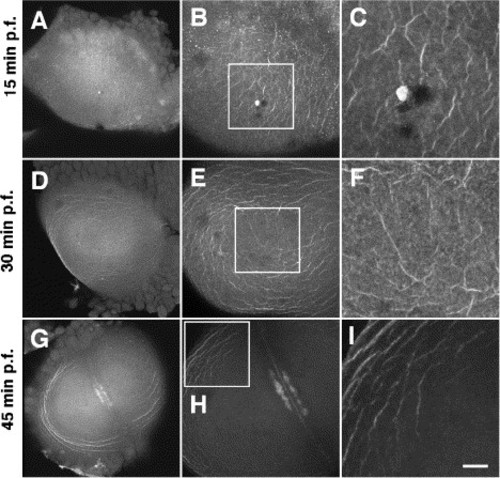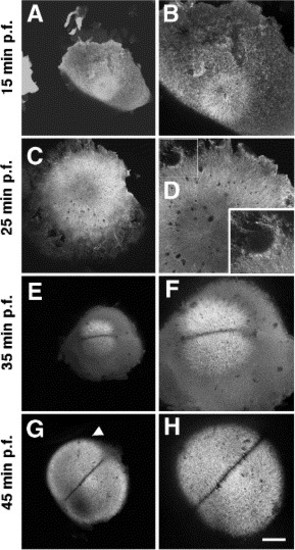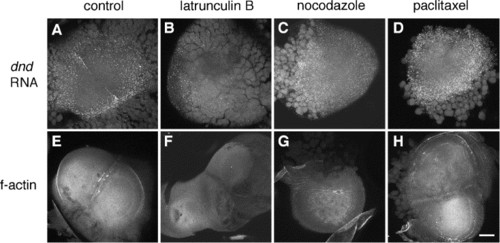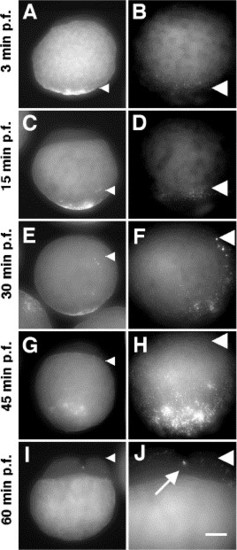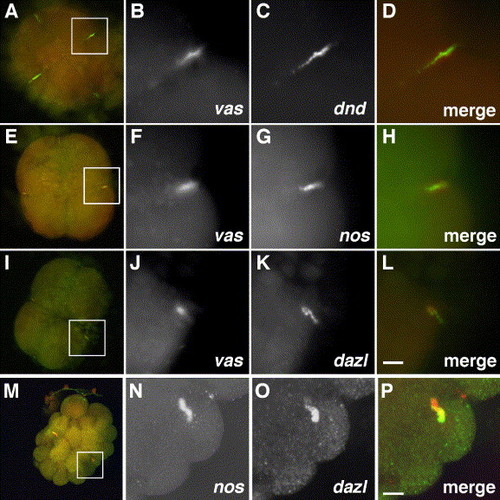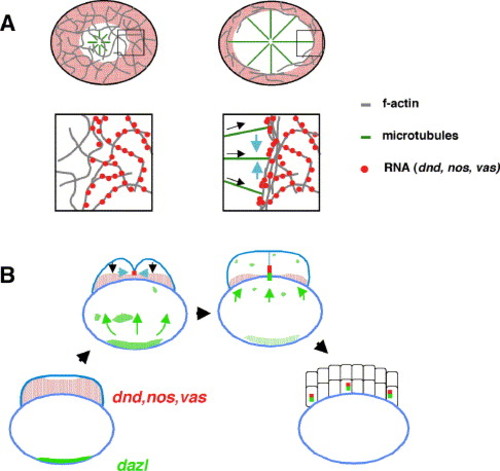- Title
-
Separate pathways of RNA recruitment lead to the compartmentalization of the zebrafish germ plasm
- Authors
- Theusch, E.V., Brown, K.J., and Pelegri, F.
- Source
- Full text @ Dev. Biol.
|
Endogenous patterns of RNA localization of dnd, nos1, vas, and dazl RNAs during the first cell cycle. Animal views of embryos fixed at progressively older stages of development (A–D: 15 min p.f.; E–H: 30 min. p.f.; I–L: 45 min p.f.) and labeled using FISH to detect germ plasm RNAs (dnd (A, E, I); nos1 (B, F, J); vas (C, G, K); dazl (D, H, L). (A–D) Immediately after fertilization, dnd, nos1, and vas RNA aggregates can be observed as a band at the animal pole, while dazl RNA aggregates are not initially present in the animal pole. (E–H) During the initiation of furrow formation, RNA aggregates for dnd, nos1, and vas begin to be recruited as a rod at the forming furrow (arrows in E–G). At this stage, dazl RNA is not yet detectable at the furrows (H). (I–L) As the furrow matures, there is an increase in the amount of dnd, nos1, and vas RNAs recruited at the furrow, and dazl RNA becomes detectable at the furrow (arrows in I–L). Scale bar in panel (L) represents 100 μm. EXPRESSION / LABELING:
|
|
RNA aggregates lie along a filamentous network, which undergoes movement towards the periphery and circumferential alignment. Animal views of embryos fixed at progressively older stages of development (A–C: 15 min p.f.; E–G: 30 min. p.f.; I–K: 45 min p.f.) and labeled using FISH to detect nos1 RNA. Panels A–C, E–G, and I–K are progressively higher magnifications of the same embryo (left column: overview; middle and left columns: square in the middle panel is shown in the right panel at a higher magnification). As development proceeds, the diameter of the RNA-free region increases (dashed double ended arrows in A, E, I) and the width of the RNA-rich band decreases (solid double ended arrows in A, E, I), reflecting the movement towards the periphery of RNA aggregates closest to the center of the blastodisc. High magnification views show that RNA aggregates lie along a filamentous network (C, G; traces along a subset of lines of aggregates in these panels are shown in D, H, respectively). The original orientation of the lines of aggregates appears random, but upon development, they tend to align circumferentially (arrowhead in G; arrows in B–D and F–H point to the center of the blastodisc). As these processes occur, the size of the RNA aggregates increases (arrowheads in J, K). Furrow formation accompanies germ plasm recruitment at the furrow (arrows in J, K), which is typically flanked by regions free of RNA aggregates (brackets in K). Scale bar in (K) represents 100 μm (left column), 50 μm (middle column), and 16 μm (right column). EXPRESSION / LABELING:
|
|
An f-actin network undergoes arrangements that are similar to those of the RNA-bound filaments. Animal views of embryos fixed at progressively older stages of development (A–C: 15 min p.f.; D–F: 30 min. p.f.; G–I: 45 min p.f.) and labeled with fluorescent phalloidin. Panels A–C, D–F, and G–I are sets of progressively higher magnifications of the same embryo (left column: overview; middle and left columns: square in the middle panel is shown in the right panel at a higher magnification). (A–C) Initially f-actin forms a network of randomly aligned cables. (D–F) As the first cell cycle proceeds, f-actin begins to move towards the periphery (note clearing of f-actin in the center of the blastodisc) and circumferential alignment (note alignment of outer cables). (G–I) These effects become more pronounced at later stages of development. The accumulation of f-actin in panels B, C highlights the second polar body, which forms after egg activation (Dekens et al., 2003). The accumulation of f-actin at the center of the blastodisc in panels G, H corresponds to f-actin enrichments that typically occur at the site of furrow formation (Kishimoto et al., 2004; A. Menzie and F.P., unpublished). Scale bar in panel I represents 100 μm (left column), 50 μm (middle column), and 16 μm (right column). |
|
Microtubule asters emanate from the center of the embryo during the early cellular cycles. Animal views of embryos fixed at progressively older stages of development (A, B: 15 min p.f.; C, D: 25 min. p.f.; E, F: 35 min p.f.; G, H: 45 min p.f.) and labeled with an anti-α-tubulin antibody. Left column: overview; right column, higher magnification views. The insert in panel D shows a higher magnification of the region labeled with a square. (A, B) Immediately after fertilization, a monoastral structure forms at the animal pole of the blastodisc. (C, D) Microtubules of this monoaster increase in length and reach the periphery of the blastodisc, which also exhibits local accumulations of shorter microtubules (inset). (E, F) Immediately prior to the first cleavage, a diastral structure flanking the prospective furrow. (G, H) As in the previous cycle, microtubules of this diaster increase to occupy more peripheral regions of the blastodisc. Scale bar in panel (H) represents 200 μm (left column) and 100 μm (right column). |
|
Interference with cytoskeletal networks affects RNA aggregates and f-actin. Animal views of embryos at 45 min p.f. after treatment with control solvent (DMSO; A, E), injection of the f-actin inhibitor latrunculin B (B, F), and treatments with the microtubule-inhibiting reagent nocodazole (C, G) and the microtubule-stabilizing drug paclitaxel (D, H), and subsequently labeled for dnd RNA (A–D) or f-actin (E–H). Latrunculin-B-injected embryos show a reduction in the number of cortical RNA aggregates (B; in this particular embryo the reduction in the number of cortical aggregates is more pronounced on the right side of the embryo, presumably due to the uneven distribution of the injected drug), as well as defects in the formation of f-actin-based structures (F; 11/15 with defects in latrunculin-B-injected embryos, compared to 1/10 in control-injected embryos). Nocodazole-treated embryos show a reduction in the RNA-free zone at the center of the blastodisc and a decrease in the formation of larger RNA aggregates normally observable at this stage (C), as well as a reduction in the degree of clearing of f-actin from the center of the blastodisc (G). Paclitaxel-treated embryos show a general increase in RNA aggregation, which is observed in more peripheral locations than normal (D) and show increased degree of actin bundling at the periphery of the blastodisc (H). Scale bar in panel (H) represents 100 μm for all panels. EXPRESSION / LABELING:
|
|
Aggregates containing dazl RNA translocate towards the animal pole along the cortex during the first cell cycle. Animal views of embryos fixed at progressively older stages of development (A, B: 3 min p.f.; C, D: 15 min. p.f.; E, F: 30 min p.f.; G, H: 45 min p.f.; I, J: 60 min p.f.) and labeled with FISH to detect dazl RNA. All images are side views: left column: overviews; right column, higher magnification views of the cortex of embryos shown in the left panels. RNA aggregates can be observed at the vegetal pole in the freshly laid egg (A, B) and in progressively more animal positions along the cortex (in all panels, arrowheads indicate the animal most limit of the cortical region containing RNA aggregates). Recruitment of dazl RNA at the furrow (arrow in J) coincides with the appearance of cortical aggregates in animal regions. Scale bar in panel J represents 200 μm (left column) and 100 μm (right column). EXPRESSION / LABELING:
|
|
Germ plasm RNAs are differentially enriched in different regions of the germ plasm. Animal views of embryos fixed at the 4-cell stage (A–L: 60 min p.f.) and the 32-cell stage (M–P: 1.75 hr p.f.) and labeled with FISH to detect different RNA pairs (A–D: vas, dnd; F–H: vas, nos1; I–J: vas, dazl; M–P: nos1, dazl). Left column: overview of merged images, right three columns: higher magnifications of the squared region in the left panels (middle two columns, in the same order as above; rightmost column, merged image with signals corresponding to the second and third columns in red and green, respectively). (A–H) During recruitment at the furrow of the 2- to 4-cells stage embryo, RNAs for dnd, nos1, and vas largely overlap (a slight enrichment in medial regions can be often observed for the nos1 RNA (F–H)). Localization of these three RNAs shows a substantial region of non-overlap with the localization of the dazl RNA (I–L). At the 32-cell stage, the differential enrichment of nos1 and dazl RNAs is maintained (M–P), showing that the germ plasm remains compartmentalized during the early cleavage stages. (A–L) Scale bar in panel L represents 100 μm (left column) and 25 μm (other three columns); (M–P) scale bar in panel P represents 120 μm (M) and 20 μm (N–P). EXPRESSION / LABELING:
|
|
Models for the recruitment of germ plasm RNAs at the furrow. (A) Cytoskeletal rearrangements and processes involved in the recruitment of early animal germ plasm RNA at the furrow. Diagrams show overview (top) and high magnification (bottom) views of embryos immediately after fertilization (left) and immediately prior to furrow formation (right). Embryos are drawn as animal views. RNA aggregates containing dnd, nos1, and vas RNAs are bound to a network of initially randomly oriented f-actin, forming a prepattern such that the central most region of the blastodisc is RNA-free. As development proceeds, the coordinated growth of astral microtubules (black arrows in bottom right inset) leads to the movement towards the periphery and circumferential alignment of f-actin. Aligned f-actin facilitates aggregation of RNA-containing particles. In a process whose mechanistic basis has not yet been addressed, lateral movement of aggregates in regions immediately adjacent to the forming furrow (blue arrows in bottom right inset) leads to the recruitment of aggregates at the furrow (not shown). (B) Relation of separate pathways of RNA segregation and the compartmentalization of the germ plasm. Embryos are drawn as side views, representing, from bottom left clockwise, a freshly laid egg, an embryo at an early stage of cellularization, an embryo at a late stage of cellularization, and an early blastula embryo. Early animal RNAs such as dnd, nos1, and vas (represented by red dots in stippled region), present in the animal cortex of the freshly laid egg undergo aggregation by the cytoskeletal rearrangements shown in (A) (black arrows) and recruitment at the furrow (large red aggregates) by proposed local lateral transport (blue arrows—see (A)). Vegetally localized RNAs such as dazl and presumably bruno-like reach the distal end of the forming aggregate at the furrow by translocation through the cortex (green arrows). These two mechanisms lead to a compartmentalized structure of the germ plasm, which is maintained during the early cleavage stages. |
Reprinted from Developmental Biology, 292(1), Theusch, E.V., Brown, K.J., and Pelegri, F., Separate pathways of RNA recruitment lead to the compartmentalization of the zebrafish germ plasm, 129-141, Copyright (2006) with permission from Elsevier. Full text @ Dev. Biol.

